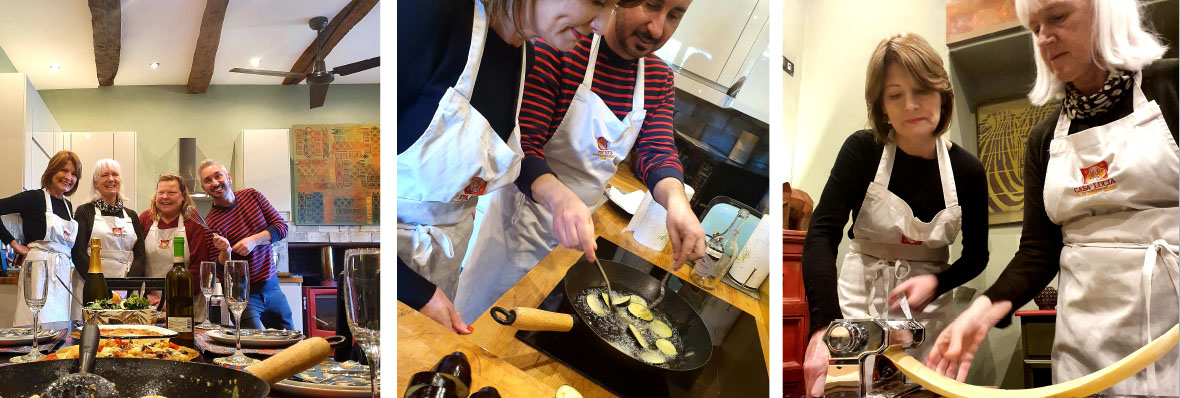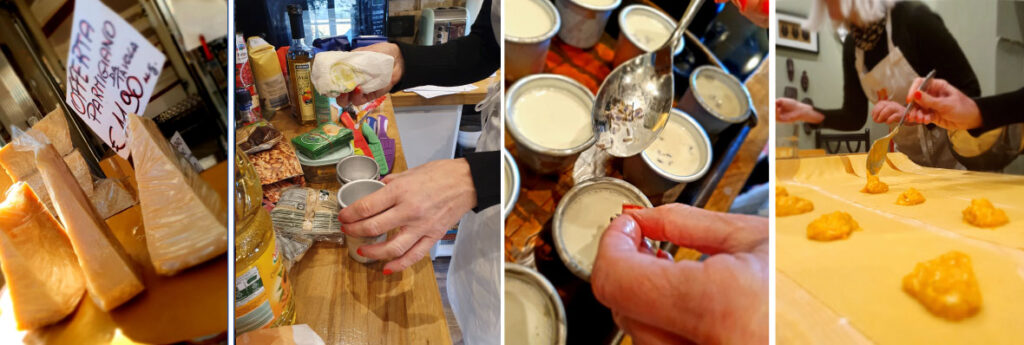Let’s face it, vacations are all about the food; and there is only one true way to get to know a region’s food – you need to go there and eat the food amongst the people who cook it and eat it every day. That way its seasoned by the fertile lands and spirited traditions of the region.
Whilst planning a long-stay trip to Italy be sure to include at least one cooking class.
Finding a good Italian cooking class, delivered in English, can be a challenge. Which is where British expat, Chef Lucy Hayward, saw an opportunity and through Casa Lucia shares her love of food and culinary skills with English-speaking visitors.
Her ‘roaming cooking classes’, which operate in the general Le Marche region, could travel to your holiday villa, or you could drive out to the scenic Tolentino area and book a day in the kitchen of Casale delle Rondini, the B&B Experience that partners with Lucy.
Four eager (and hungry) students, ready to learn.
The day starts in a local open-air farmer’s market. Under the guidance of Chef Lucy, we learn what to look for when picking ingredients that are unspoilt, full of honesty and freshness, and comes from soil that hasn’t been messed with.
Armed with bulging paper bags, containing Aubergines (eggplant), tomatoes, herbs, spices, and some pasta flour, we head to a local kitchen for the day’s tuition. After the first Prosecco cork is popped, we began cleaning and preparing for the feast.
If you want hands-on training in traditional Italian cooking, this is it.
As all things should, the food prep began with dessert: Lavender panna cotta – the sort of dessert one might consider if angels were coming to dinner: a fragile mound of sweetened cream, speckled with edible lavender, and set with a single leaf of gelatin.
Lucy explains that the heart and soul of this recipe is the cream. “Don’t use anything less than the best as this provides the principal texture and flavour. I do like to buy Marchigiani cream where I can.” She explains too that you need just a little sugar, less than most recipes suggest.
Each of Italy’s regions boast a distinctive cuisine – Marche is known for their bold flavours.
With dessert still in mind, we continued and prepared Almond Cantuccini – the unmistakable diagonally cut, twice-baked biscuits – Italy’s best-known cookies – perfectly paired with a glass of vin santo. Lucy suggested we form the dough into small loaf shapes and bake them for around 20 minutes then, when slightly cooled, slice them, then bake for a second time, until dry.
With the panna cotta setting in the fridge, and the Cantuccini cooling on the oven racks, the focus shifts to Focaccia: a fragrant bread, topped with a handful of cherry tomatoes and fresh basil. It’s a simple, classic Italian bread, served alongside pasta dishes. Today we married ours to a crispy Fennel & Orange salad.
With the kitchen filled with laughter, we move onto building an Aubergine Parmigiana. It’s a layered affair of eggplant, lavish handfuls of mozzarella and parmesan (every time I smell cheese like this, I get emotional) and plump tomatoes, baked in the oven.
Ingredients tend to end up in recipes for different reasons. Sometimes it’s because they come from the same part of the world. Like peppers, and tomatoes, things that grow in the same soil. It’s like they were always meant to share a pot. As was the case here.
A hands-on cooking class that has you making pasta.
For me, this was the one I feared most; the one I’d not master – making the pasta dough from scratch! It was surprisingly easy; all it took was ‘00’ flour, a couple of eggs and some wrist action for kneading. Then it was fed into a pasta machine, producing wafer thin sheets to create the Ravioli.
Lucy asserted herself: “I need to be able to read the newspaper through those pasta sheets.”
Using an obscure object, Ravioli shapes were cut out, then filled with roasted butternut, crumbed ricotta, nutmeg, later dressed in browned butter oozing with sage, and walnuts, then sprinkled with grated parmesan. The filling was light on the cheese, and heavy on the butternut, making them healthy, with a sweet-savory flavor that perfectly complements the sage butter sauce.
Lucy explained that cooking the pasta needs the water to be just simmering – boiling water will tear or break the pasta; it’s also easier to ascertain when the pasta is perfectly cooked.
Dining at a table groaning under the weight of an Italian banquet.
The day-long cooking marathon finished in the late afternoon. We gathered at the table where aromas hovered above the plates. We drank wine, chatted, laughed, and feasted on the essence of Italy.
When the Ravioli appeared, a hush descended on the table. I placed the first circle of Ravioli on my tongue; al dente, just how it should be. I lifted my tongue to the roof of my mouth and felt the Ravioli flavors merge and melt. I could tell the ingredients had spent sufficient time together to get to know one another. It was a perfect parcel of butternut, ricotta, nutmeg, and sage butter sauce.
This was where my love affair with Italian food began. It was a religious experience, central heating for my soul, love at first bite, catnip even. I drew it out for as long as I could as I knew I would never get to taste Ravioli like this again. Ever.
When we parted company, we did so with embraces, promises to stay in touch, food to take home, and the recipes of all we’d cooked.
By special arrangement, Lucy can create a bespoke menu for an Italian cooking class at your holiday villa in the Le March region. Alternatively, request attendance at a class hosted by Casale delle Rondini, a gorgeous B&B that collaborate with Lucy’s cooking school.
Cooking class rates €150 per person.
www.casalucia.org

About Lucy:
Although Lucy now lives and works in Italy, her heritage is Polish. Her love of food was born at the knee of her Polish grandmother and mother, who cooked what in Italy is referred to as ‘cucina povera’ the cooking of the poor or peasant. It’s a cooking style which focuses using every morsel, and has one re-evaluate what gets binned – like the outer leaves of a cabbage or cauliflower. Sliced thinly and tossed in olive oil and a drizzle of butter, salt, and pepper, delivers a punchy and tasty side dish, or a more substantial meal if mixed with other veggies. All this from something most of us would throw out, or at best, feed to the chickens.
This love of maximizing food value is evident throughout the Le Marche region. This, alongside the quality of local produce and attending numerous cookery schools, is what convinced Lucy to move to Italy. A real ‘dream come true’.
Where to sleep
The village of Tolentino (Le Marche region) is just 30 minutes from both the famed Sibillini mountains and the beautiful Adriatic coast. Here, surrounded by rolling green hills, you’ll find Casale delle Rondini, an elegant 2-bedroomed B&B, which also has a private apartment. The double rooms are tastefully restored to their terracotta and pastel rustic roots. Complete with spacious ensuite bathrooms, the establishment has all the whistles and bells for 21st century living.
Other than birdsong, there is no noise and peaceful tranquility as there are few people in the area. Yet we are close enough to the ancient cities for day trips.
Start the day with a substantial Continental breakfast in the gazebo, taking in the views across the manicured garden, the swimming pool, and the mountain villages beyond. Your hosts Francesco and Robert will suggest places to visit and advise about the best restaurants suited to your palate.
Room rates €120 ($162) per night
info@oliviotree.com
Instagram: casaledellerondinitolentino

